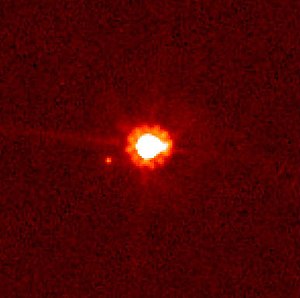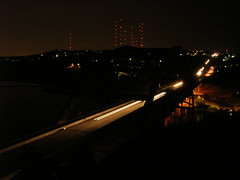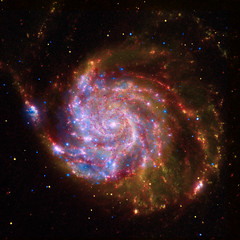It’s official: THERE WATER IN THE MOON. The data brought by two spacecrafts points out to only one conclusion, there is a substantial amount of water in the moon. The two satellites are the Lunar
Reconnaissance Orbiter and the LCROSS satellite. But these two satellites just adds up to the data provided by three previous spacecrafts that shows some evidence of the existence of hydrogen-oxygen bonds on the surface of the moon.
India’s first ever lunar probe, Chandrayaan-1 launched October 2009 and began operating August 2009 was the latest among those three. Equipped with Moon Mineralogy Mapper (M3) it was able to detect certain wavelengths of light reflected in by the sun-lit surface that indicates a bond of hydrogen and oxygen, which can either be Hydroxyl or water.
In 1999, Cassini passed by the moon on its way to Saturn and gave back some evidence of hydroxyl/water presence which is slightly stronger near the poles.
Deep Impact spacecraft gives the same evidence when it used infrared to scan the moon’s surface.
Though evidence points to the existence of water in the moon, its origin is still fuzzy. It may either be brought from the outside through water containing comets or by solar wind. The other possibility is even more intriguing—that the moon was itself was the origin of water.
For more details on this, Google it!
November 13, 2009
August 25, 2009
Astronomy History: 400 years ago
Yesterday, August 25, marks the 400th years from the time that an Italian mateghematician in the name of Galileo Galilei focused the telecope into the heavens. This momentous event opened the way to new understanding of man's position in the universe.
Galileo observed many fascinating sights. One is the geography and topography of the moon,
If Galileo was still alive today, he would have been very happy about the dramatic increase of knowledge and understanding of the universe compared to his days. But even today's knowledge about the universe is only a scratch of the things yet to be discovered.
Galileo observed many fascinating sights. One is the geography and topography of the moon,
 Image via Wikipedia
Image via Wikipedia
Photo (right) The Phases of Venus proves the Heliocentric (sun-centered) universe model by Copernicus.
Galileo immediately announced this newly found truth about the sun being the center of the universe, but the Catholic Church's support of Geo-centric universe never changed. Instead,
 Image via Wikipedia
Image via Wikipedia
galileo was put to house arrest until his death for teaching such information that they view as heresy.
Photo (right). Galileo facing the Roman Inquisition.
If Galileo was still alive today, he would have been very happy about the dramatic increase of knowledge and understanding of the universe compared to his days. But even today's knowledge about the universe is only a scratch of the things yet to be discovered.
August 15, 2009
Pluto-Failed Planet?
Pluto still failed to be recognized as a planet after this week's international astronomical meeting held by the International Astronomical Union (IAU) in Rio Janeiro. We can still recall the controversial move made by the IAU to demote Pluto as a "dwarf planet" three years ago in the same meeting held in Prague. The world witnessed table bangings and walk outs of some astronomers after the decision has been laid down.
The decision was based on the fact that it failed to pass the criteria to be major body on it's orbit. Pluto's mass only accounts for 0.07 of the entire mass of all objects in its orbit (which includes gas giant Neptune because their obits intersect). In contrast, earth is more than a million times heavier than all the objects on its orbit (which includes the moon).
Pluto joined the group of the dwarf planets that includes Ceres, Haumea, Makemake, and Eris.
 Image by Image Editor via Flickr
Image by Image Editor via Flickr
The decision was based on the fact that it failed to pass the criteria to be major body on it's orbit. Pluto's mass only accounts for 0.07 of the entire mass of all objects in its orbit (which includes gas giant Neptune because their obits intersect). In contrast, earth is more than a million times heavier than all the objects on its orbit (which includes the moon).
Pluto joined the group of the dwarf planets that includes Ceres, Haumea, Makemake, and Eris.
 Image via Wikipedia
Image via Wikipedia
(Right)The orbit of Haumea
(Right) Image of Eris and its moon Dysnomia
(Below) Pluto and its moons.
 Image via Wikipedia
Image via Wikipedia
(Right) Image of Eris and its moon Dysnomia
(Below) Pluto and its moons.
 Image by the mad LOLscientist via Flickr
Image by the mad LOLscientist via Flickr
Posted by
Admin
at
6:39 AM
0
comments

 Labels:
astronomy,
Ceres,
Dwarf planet,
International Astronomical Union,
Pluto,
Solar System
Labels:
astronomy,
Ceres,
Dwarf planet,
International Astronomical Union,
Pluto,
Solar System
August 12, 2009
Perseids Meteor Shower Tonight!
Do you want to hangout tonight? We'll I have a great idea!
Persieds is an annual meteor shower that starts by the middle of July and peaks in the middle of August. For this year, 2009, it is expected to peak between August 11 and August 12. According to recent counts, it can showers up to 60 shooting stars per hour or more. It's really a shower of fun to observe this wonderful celestial event.
Meteor showers occur when the earth passes an orbit of a comet. Comets leaves particles of rocks and ice on their orbit and when the earth passes them, a steady shower of meteor display occurs.
Perseids meteor shower can be observed all over the sky but more concentrated on the Northern part specifically on the contellation of Perseus. The comet named Swift-Tuttle is the one associated with it.
 Image by rherring via Flickr
Image by rherring via Flickr
Persieds is an annual meteor shower that starts by the middle of July and peaks in the middle of August. For this year, 2009, it is expected to peak between August 11 and August 12. According to recent counts, it can showers up to 60 shooting stars per hour or more. It's really a shower of fun to observe this wonderful celestial event.
 Image via Wikipedia
Image via Wikipedia
Meteor showers occur when the earth passes an orbit of a comet. Comets leaves particles of rocks and ice on their orbit and when the earth passes them, a steady shower of meteor display occurs.
 Image by Getty Images via Daylife
Image by Getty Images via Daylife
Perseids meteor shower can be observed all over the sky but more concentrated on the Northern part specifically on the contellation of Perseus. The comet named Swift-Tuttle is the one associated with it.
Another well known meteor shower and
currently the holder of Guiness Book record is the Leonids that occurs on November and is caused by the comet Temple-Tuttle. In 1833, 1866 and 1867, it displays the most expectacular meteor showers of all time when it rained up to 100,000 meteors per hour!
 Image via Wikipedia
Image via Wikipedia
Posted by
Admin
at
4:50 AM
0
comments

 Labels:
109P/Swift-Tuttle,
Comet,
Meteor shower,
Meteoroid,
Perseids
Labels:
109P/Swift-Tuttle,
Comet,
Meteor shower,
Meteoroid,
Perseids
August 10, 2009
Astronomy Basics
I found this cool article about astronomy in scribd.com. I want to share this to my readers in case they want a basic idea of what astronomy involves. Cool pictures of the stars, the moon, the planets, the sun and everything in the heaven.
Astronomy Part1
Enjoy!!!!
July 16, 2009
July 11, 2009
Astronomy in the Philippines
Astronomy is one of the basic sciences that were still unexplored here in the
Granted, the importance of astronomy in the Philippine setting is quite low. I think that it was the reason why no one (or maybe few) in the government ever focus its attention in improving the awareness of the people. And I definitely agree that the government faces even more important problems that need their full focus.
PAG-ASA
The Philippine Atmospheric Geophysical and Astronomical Services Administration (PAG-ASA) is the sole government entity who is commissioned to provide awareness to the people about astronomy. Sadly, due to more important priorities like weather and other natural disasters occurring in the country, it only focuses its limited budget to weather forecasting. Again, I totally agree with them. It’s the right thing to do.
The Good News
Though astronomy in the Philippines is generally poor, there are still reasons to rejoice. Though lacking unity, there are a lot of scattered private organizations in the country that promote awareness about the science of heavenly bodies. These groups consist of professional and amateur astronomers, students, and other astronomy enthusiasts. It’s very nice to know that the interest of the Filipinos on astronomy is not absolutely empty.
Also, the Rizal Technological University of the Philippines (RTU) became the first educational institution to offer the first ever astronomy college course in the country. Though the initial enrollees on the Bachelor of Science (BS) in Astronomy Technology are just few, it is a signal that the celestial science in the country is off to a good start. They also offer Masters of Science in Astronomy for those who want to take up Masters Degree.
Authors Note
It seems like astronomy in the Philippines is getting the right push. This year 2009 was declared as the International Year of Astronomy (IYA2009). Its mission is to help the citizen in the world (including us, Filipinos) rediscover its place in the universe through day and night time sky and thereby engage a personal sense of wonder and discovery. It’s very nice to know that the Philippines is one of the active nations on the program 100 Hours of Astronomy (100HA).
Yes, though it may not have direct effects as other sciences have on Filipino lives, no one could dispute the fact that astronomy has an impact on the world we live in.
This blog is dedicated to provide some ideas on astronomy not only in the Philippines but on the entire globe.
External Readings
http://www.astronomy2009.ph
http://www.astroleaguephils.org
 Image by Getty Images via Daylife
Image by Getty Images via Daylife
Granted, the importance of astronomy in the Philippine setting is quite low. I think that it was the reason why no one (or maybe few) in the government ever focus its attention in improving the awareness of the people. And I definitely agree that the government faces even more important problems that need their full focus.
PAG-ASA
The Philippine Atmospheric Geophysical and Astronomical Services Administration (PAG-ASA) is the sole government entity who is commissioned to provide awareness to the people about astronomy. Sadly, due to more important priorities like weather and other natural disasters occurring in the country, it only focuses its limited budget to weather forecasting. Again, I totally agree with them. It’s the right thing to do.
The Good News
 Image by Smithsonian Institution via Flickr
Image by Smithsonian Institution via Flickr
Though astronomy in the Philippines is generally poor, there are still reasons to rejoice. Though lacking unity, there are a lot of scattered private organizations in the country that promote awareness about the science of heavenly bodies. These groups consist of professional and amateur astronomers, students, and other astronomy enthusiasts. It’s very nice to know that the interest of the Filipinos on astronomy is not absolutely empty.
Also, the Rizal Technological University of the Philippines (RTU) became the first educational institution to offer the first ever astronomy college course in the country. Though the initial enrollees on the Bachelor of Science (BS) in Astronomy Technology are just few, it is a signal that the celestial science in the country is off to a good start. They also offer Masters of Science in Astronomy for those who want to take up Masters Degree.
Authors Note
It seems like astronomy in the Philippines is getting the right push. This year 2009 was declared as the International Year of Astronomy (IYA2009). Its mission is to help the citizen in the world (including us, Filipinos) rediscover its place in the universe through day and night time sky and thereby engage a personal sense of wonder and discovery. It’s very nice to know that the Philippines is one of the active nations on the program 100 Hours of Astronomy (100HA).
Yes, though it may not have direct effects as other sciences have on Filipino lives, no one could dispute the fact that astronomy has an impact on the world we live in.
This blog is dedicated to provide some ideas on astronomy not only in the Philippines but on the entire globe.
External Readings
http://www.astronomy2009.ph
http://www.astroleaguephils.org
July 1, 2009
2009-International Year of Astronomy
2009 is the International Year of Astronomy. This is also the year I decided to come back to who I am ten years ago.
The heavens is calling me back...I cannot refuse...
The heavens is calling me back...I cannot refuse...

Please join me in rediscovering the fantastic world of astronomy. Let's explore the universe and be drowned with awe and reverence to its Creator.
Subscribe to:
Posts (Atom)


![Reblog this post [with Zemanta]](http://img.zemanta.com/reblog_e.png?x-id=8fe5372d-357b-4f9c-b5a6-201b2b94af67)
![Reblog this post [with Zemanta]](http://img.zemanta.com/reblog_e.png?x-id=3983138f-d867-411d-bca4-8ee73a078dc7)
![Reblog this post [with Zemanta]](http://img.zemanta.com/reblog_e.png?x-id=bfaa9338-cc13-4ba7-809c-649b1268f18c)
![Reblog this post [with Zemanta]](http://img.zemanta.com/reblog_e.png?x-id=ea2b1a78-2453-4f2d-802a-9a35d5ffa11f)